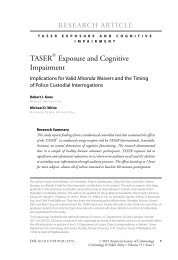1qaSADJ
1qaSADJ
1qaSADJ
You also want an ePaper? Increase the reach of your titles
YUMPU automatically turns print PDFs into web optimized ePapers that Google loves.
Special Focus:<br />
Writing Persuasively<br />
me to begin with discussions of two compelling works I assign for summer reading: The<br />
Autobiography of Malcolm X and The Things They Carried by Tim O’Brien.<br />
Benefits<br />
The success of this combined program depends a great deal on the compatibility of the<br />
teachers involved, of course, but generally our collaborative efforts have motivated and<br />
inspired students to see the relevance of information and analytical techniques in one<br />
course to the other. In the best of circumstances, knowledge gained in one class reinforces<br />
and expands that learned in the other. While studying the causes of the American<br />
Revolution, students discuss the significance of Thomas Paine’s pamphlet entitled<br />
“Common Sense.” Armed with the knowledge that Paine’s audiences consisted of Loyalists<br />
and Patriots, students are more likely to recognize the rhetorical strategies Paine used to<br />
balance his argument in order to persuade as many colonists as possible.<br />
This schedule allows us to combine forces when we are working with an especially rich<br />
and important text. Nick and I team-teach several times a month by planning a double<br />
period of related activities. Students might read Lincoln’s Gettysburg Address for both<br />
classes, focusing on the historical context in one, the rhetorical techniques in the other.<br />
We then follow this discussion by asking students to write a piece emulating Lincoln’s<br />
style and strategies, taking into account how the history of the time period informs the<br />
piece. Nick and I jointly evaluate such an activity.<br />
Improved grades on the AP Exams measure the most tangible benefit of this<br />
interdisciplinary approach. At Floral Park High School, exam grades have improved in<br />
both AP English Language and AP U.S. History; last year, we had more students earn a<br />
5 than in any previous year. On the more qualitative side of evaluation, we see students’<br />
motivation improving. Apparently, word is spreading, since enrollment in the AP courses<br />
is growing. Nick and I now teach three sections, which means six of the eight periods<br />
in our school day are combined AP English Language and AP U.S. History sections.<br />
Our success and enthusiasm is leading to more collaborative efforts. Our tenth-grade<br />
advanced English class is now linked to AP World History, and our superintendent is<br />
exploring ways to (re)establish similar linkages in the ninth grade throughout the district.<br />
Finally, this may be anecdotal, but we are hearing reports from students who have gone<br />
on to college that the synergy of our combined program has contributed to their success<br />
by making them better and more confident readers, writers, and analysts who see the<br />
broader picture when approaching written texts.<br />
AP® English Language and Composition: 2006–2007 Workshop Materials 39



